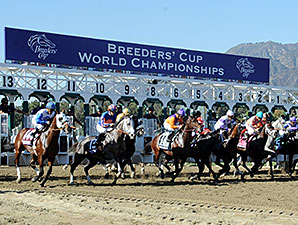BC Juveniles Show Few Cases of EIPH

An observational study has found that 2-year-olds racing without race-day furosemide at the 2013 Breeders' Cup World Championships at Santa Anita Park had fewer and less severe instances of exercise-induced pulmonary hemorrhage than juveniles who raced with the diuretic that same weekend at Santa Anita.
While the study was observational as opposed to scientific—and the sample size small—researchers observed a statistically significant higher percentage of EIPH frequency, and severity, in horses treated with furosemide Nov. 1 at Santa Anita compared with those who raced without it that weekend at the track.
Furosemide (commonly called Salix or Lasix) is the only race-day medication permitted in North American racing and it's used to treat EIPH, which at its most severe grade can include bleeding through the nostrils. Breeders' Cup has prohibited race-day Salix use in juvenile races in the two most recent World Championships.
This year Breeders' Cup followed up that Salix policy with endoscopic exams for EIPH of juveniles whose connections opted to participate in the voluntary study, which also looked at horses volunteered from a pair of stakes races for juvenile California-breds conducted that same weekend.
Dr. Nathan Slovis, DVM, Dipl. ACVIM, CHT, led the voluntary study that saw Hagyard Equine Medical Institute conduct endoscopic examinations of 55 juveniles shortly after the races. In the study, 71% of the horses who raced with Salix (10 of 14) were observed to have some level of EIPH while just 37% of the non-treated horses (15 of 41) showed some level of EIPH.
EIPH was graded on a four-grade (four being most severe) scale and the Salix-treated horses again showed significantly higher numbers of severe bleeding, as 36% (5 of 14) showed grade three or grade four EIPH, compared with only 7% (3 of 41) at those grade levels in the non-treated group.
While careful to acknowledge the study's limitations, Slovis concluded there was no evidence EIPH was more severe in 2-year old horses not treated with furosemide. Slovis said the study was statistically significant to this group of horses, racing that weekend.
Slovis said some of the other factors besides small sample size that limited the study included its scope, looking at just stakes-level juveniles. He also noted the Breeders' Cup (non-Lasix) pool of horses could have been impacted by connections choosing not to race horses they thought might be at-risk for EIPH.
"We must interpret these results with care because of these limitations," Slovis said.
The voluntary study saw 55 of the 78 2-year-old starters who raced that weekend at Santa Anita examined. Of the 55 participants, 41 raced without Salix in the four World Championships races and the Breeders' Cup Turf Sprint and 14 raced with Salix in a pair of juvenile races for California-bred horses conducted Nov. 1.
In the Cal-bred races, all 19 horses competed with Salix and 14 participated in the study. The Salix-prohibited Breeders' Cup races saw 41 of 59 starters participate.
A scientific study conducted in 2011 in South Africa determined furosemide reduced the frequency and severity of EIPH. Slovis considers the South African study excellent scientific work and was somewhat surprised when he didn't see similar results in the Breeders' Cup observational study.
"I went in with an open mind but I went into this thinking that the horses who had been treated with Lasix would have lower and less severe instances," Slovis said.
After announcing the observational study results Dec. 16, Breeders' Cup representatives did not announce any policy changes for its World Championships going forward.
Breeders' Cup had planned to conduct Salix-free racing at its 2013 World Championships but ultimately decided to keep its 2012 policy of prohibiting race-day Salix in only its four juvenile races in place while permitting the diuretic in its other races. The Breeders' Cup currently does not plan to prohibit Salix from any races at the 2014 World Championships.
Breeders' Cup president Craig Fravel said the observational study shows a need for further scientific study.
"Beyond the stated conclusions which, given prevailing sentiment are both striking and surprising, this observational study reinforces our commitment to investing in research focused on EIPH," Fravel said. "We urge the racing industry to reflect thoughtfully on the results and to support further scientific inquiry into this and other critical areas. We look forward to follow-up on this study to identify further research approaches the work might suggest and expect to meet with colleagues at the CHRB, TOC, and elsewhere to advance the science in this critical area."
In conjunction with extending the 2012 medication policy, Breeders' Cup committed to the California Horse Racing Board and the Thoroughbred Owners of California that it would fund post-race endoscopic examination of the starters in these races and publish the findings. Slovis believes the observational study points to the need for further scientific study and could help shape those studies.
"Although there were limitations on the scope of the study in terms of sample size and others noted in the report, we believe the data can be quite useful in identifying further studies that can advance our understanding of the causes and impact of EIPH on the racing Thoroughbred," Slovis said. "We look forward to working with the Breeders' Cup and others to advance our level of knowledge on the subject of EIPH and the use of furosemide as a preventive medication."
With Breeders' Cup currently not planning any Salix-free races in 2014, Fravel said those studies could involve horses owned by Thoroughbred Owners' and Breeders' Association members that have pledged not to race their juveniles on Salix. Dr. J. David Richardson, a surgeon and Breeders' Cup board member, noted that studies also are needed to look at exactly how Salix acts in relation to EIPH and to examine any side effects associated with its use.
